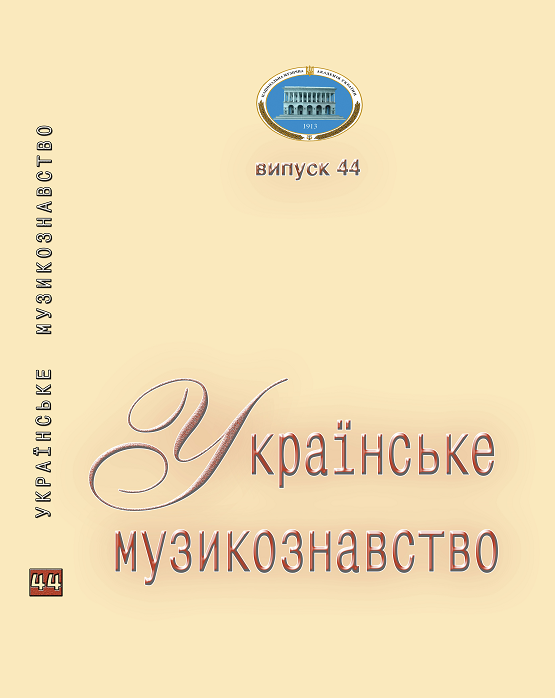Historical Information about Greek Chant in the Ukrainian and Belarusian Church Tradition (XVI – XVIII centuries)
DOI:
https://doi.org/10.31318/0130-5298.2018.44.0.152523Keywords:
Ukrainian and Belarusian church tradition, Greek chant, and historical informationAbstract
Relevance of the study. Approximately 10 % of the Ukrainian liturgical musical manuscripts of the 16th – 18th centuries contains the tunes accompanied with the remark 'Greek'. In the Ukrainian humanitarian science there is still no special work devoted to the collection, analysis and systematization of the historical information about Greek chant in the Ukrainian and Belarusian church tradition. The reasons for the absence of such research are the complexity of the task and the imperfection of the existing systems for information searching.
The main objective of our study is to present some historical information shedding light on the phenomenon of Greek chant in the Ukrainian and Belarusian church tradition of the 16th –18th centuries presented.
Methodology. The Moldavian governor Alexander Lăpuşneanu’s letter to the Lviv Assumption Brotherhood, the polemic essay “Exegesis” of Sylvester Kosov, “The Travels of the Patriarch Maсarius of Antioch written by his Son and archdeacon Paul of Aleppo”, the Barnaba’s Preface to the Heirmologion of the Manyava Skete 1684, the remarks of the Heirmologion of Suprasl 1601 and the Oktoechos of Kallistrat 1769 were analyzed. Some sources added to the musicological study for the first time.
Results and their significance. The historical information enables us:
- to find out the ways in which Greek chant was brought to the Ukrainian and Belarusian lands from the Greek East – they ran through Bulgaria and Moldovlakhia;
- to answer the questions, where and how the Ukrainian singers mastered Greek chant;
- to raise the question about the reasons for the Greek chant’s appearance and spread;
- to understand how the Greek chant was perceived, what place it occupied in the religious and social life;
- to trace the influence of the borrowed eastern chants on the further development of the Ukrainian and Belarusian church tradition.
The scholars’ comments and hypotheses concerning the historical sources and facts were systematized, some hypotheses have been confirmed.
References
Ignatenko, Ye. (2011), Kallistrat’s Greek Oktoechos in the Context of the Orthodox chant books, Journal of Tchaikovsky National Music Academy of Ukraine [Grecz`kyj Osmoglasnyk Kallistrata u konteksti pravoslavnoyi spivacz`koyi knygy, Chasopys Nacional`noyi muzychnoyi akademiyi Ukrayiny imeni P. I. Chajkovs`kogo, Кyiv, no. 1 (10), pp. 55–63. [in Ukrainian]
Ignatenko, Ye. (2017), Hesychasm and Greek chant at Ukrainian and Belarusian lands in the second half of the 16th – 17th c., Scientific Review of Ukrainian National Tchaikovsky Academy of Music [Isyxazm i grecz`kyj spiv na ukrayins`kyx i bilorus`kyx zemlyax u drugij polovyni XVI–XVII st., Naukovyy visnyk NMAU im. P. I. Chaykovs'koho, Kyiv, issue 119, pp. 148–169. [in Ukrainian]
Isayevych, Ya. (2002), Brotherhoods and Ukrainian music culture of the XVI–XVIІІ centuries, KALOFΩΝΙΑ / KALOPHONIA: Wissenschaftlicher Sammelband aus der Geschichte der Kirchlichen Monodie und Hymnographie [Bratstva j ukrayins`ka muzychna kul`tura XVI– XVIII sto-lit`, KALOFΩΝΙΑ / KALOPHONIA: naukovyj zbirnyk statej i materialiv z istoriyi cerkovnoyi monodiyi ta gymnografiyi, Lviv, issue 1, pp. 8–18. [in Ukrainian]
Kossov, S. (1914), Exegesis, Archive of Southwestern Russia [Exegesis, Arhiv YugoZapadnoy Rossii, in Polish], Kiev, part 1, vol. 8, pp. 422–447.[in Russian]
Lutsyk, R. (1937), The Church of the Virgin’s Assumption in Lviv, Anniversary Collection in Commemoration of the 350th Anniversary of Lviv Stavropigion. Part II. The Temporary. Scientific and Literary Notes of Lviv Stavropigion for 1936 and 1937 [Hram Uspeniya Bogoroditsyi vo Lvove, Yubileynyiy sbornik v pamyat 350-letiya lvovskogo Stavropigiona. Ch. II. Vremennik. Nauchno-literaturnyie zapiski lvovskogo Stavropigiona na 1936 i 1937 godyi, in Russian], Stauropegion Institute in Lviv, pp. 48–51. [in Russian]
Mashtafarov, A., Florya, B. (2001), Arsenios of Elasson, Orthodox Encyclopedia [Arseniy Elassonskiy, Pravoslavnaya entsiklopediya, Moscow, vol. 3, pp. 442–446 .[in Russian]
Mytsko, I. (1990), Ostroh Slavic-Greek-Latin Academy (1576–1636) [Ostroz`ka slov'yano-greko-latyns`ka akademiya (1576–1636), Kyiv, 191 p. [in Ukrainian]
Nimchuk, V. (2009), The Vinnytsia center of education in the XVII century, Ukrainian Language [Vinnycz`kyj oseredok osvity u XVII st., Ukrayins`ka mova, no. 1, pp. 109–112. [in Ukrainian]
Oktoechos of Kallistrat from the Moldavian Monastery in Dragomirna, 1769 (2005) [Osmoglasnyk Kallistrata z moldovs`kogo monastyrya v Dragomyrni. 1769 rik]. Decoding of musical and verbal texts Ya. Mykhailuk, O. Tsalay-Yakymenko, Poltava–Kyiv–Lviv, 102 p. [in Ukrainian]
Paisius Velichkovsky (2016), “Story about the holy cathedral” and little-known letters [«Povist` pro svyatyj sobor» ta malovidomi lysty], Ordering, Preface, Scientific research and Comments by Shumylo, S., Kyiv, 207 p. [in Ukrainian]
Letters from the Moldavian sovereign Alexander to the Lvov brotherhood (1863), Acts Relating to the History of Southern and Western Russia: Compiled and Published by the Archaeographic Commission [Pisma Moldavskogo gospodarya Aleksandra k Lvovskomu bratstvu, Aktyi, otnosyaschiesya k istorii Yuzhnoy i Zapadnoy Rossii: sobrannyie i izdannyie Arheograficheskoyu komissieyu], ed. N. Kostomarov, Saint Petersburg, vol. 1: 1361–1598, 322 p. [in Russian]
Meetings’ Protocols of the Lviv Stauropegion Brotherhood of 1599–1650 (1904), Archive of Southwestern Russia [Protokolyi zasedaniy Lvovskogo Stavropigialnogo bratstva 1599–1650 gg., Arhiv Yugo-Zapadnoy Rossii], Kiev, part 1, vol. 11, pp. 58–163.[in Russian]
The Travels of the Patriarch Maсarius of Antioch to Russia in the middle of the 17th century written by his Son and archdeacon Paul of Aleppo (1897), [Puteshestvie antiohiyskogo patriarha Makariya v Rossiyu v polovine XVII veka, opisannoe ego syinom, arhidiakonom Pavlom Aleppskim], translation from Arabic of G. Murkos, issue 2: From the Dniester to Moscow, Moscow, 202 p.[in Rassian]
Razumovsky, D. (1867), Church Singing in Russia [Tserkovnoe penie v Rossii], Moscow, issue 1, pp. 1–136.[ in Russian]
Register of musical notebooks belonging to the Lviv Stauropigion Brotherhood, 1697 (1904), Archive of Southwestern Russia [Reestr notnyih tetradey, prinadlezhaschih Lvovskomu Stavropigialnomu bratstvu, 1697 g., Arhiv Yugo-Zapadnoy Rossii], Kiev, part 1, vol. 12, pp. 62–71.[ in Russian]
Register of musical notebooks belonging to the Lviv Stauropigion Brotherhood, 1697 (1971), [Reyestr notnyx zoshytiv, shho nalezhaly L`vivs`komu Stavropigial`nomu bratstvu, 1697 r., Ukrainian Musicology [Ukrayins`ke muzykoznavstvo], Musical Ukraine, Kyiv, issue 6, pp. 245–251.[in Ukrainian]
Siredzhuk, P. (2011), Known and unknown pages of Manyavsky Skyt tablets, The Carpathians: Populace, Ethnos, Civilization [Vidomi j nevidomi storinky skryzhalej Manyavs`kogo Skytu, Karpaty: lyudyna, etnos, cyvilizaciya], Play, Ivano-Frankivsk, vol. 3, pp. 27–34.[in Ukrainian]
Toncheva, E. (1981), The Velikij Skit (Skit Mare) Monastery – a School of «Bolgarskij Rospev». «Bolgarski» Heirmologia of the 17th – 18th centuries from the Skit Monastery [Manastir't Golyam Skit – shkola na «bolgarskiy rospev». Skitski «bolgarski» Irmolozi ot XVII–XVII v.], in 2 vol., Music, Sofia. 19.Florovsky, G. (1983), The Ways of Russian Theology [Puti russkogo bogosloviya], the third edition with preface of I. Meyendorf, YMCA-PRESS, Paris, 600 p.[in Russian]
Chetverikov, S. (2006), Moldavian Elder Paisius Velichkovsky. His life, teaching and influence on Orthodox monasticism [Moldavskiy starets Paisiy Velichkovskiy, ego zhizn, uchenie i vliyanie na pravoslavnoe monashestvo], Minsk, 375 p.[ in Russian]
Chudinova, I. (1991), Church singers Ukrainians of Alexander Nevsky Monastery (to the question of the role of Ukrainian influences on the formation of St. Petersburg’s culture), From the History of Ukrainian Musical Culture [Klyroshany-ukrayinci Oleksandro-Nevs`kogo monastyrya (do pytannya roli ukrayins`kyx vplyviv na stanovlennya peterburz`koyi kul`tury), Z istoriyi ukrayins`koyi muzychnoyi kul`tury], Kyiv, pp. 53–63.[ in Ukrainian]
Yasynovs'kyi, Yu. (1996), Ukrainian and Belarusian staff-notated Heirmologia of the 16th – 18th centuries. Catalogue and paleographical study [Ukrayins'ki ta bilorus'ki notoliniyni Irmoloyi 16–18 stolit'. Kataloh i kodykolohichno-paleohrafichne doslidzhennya], Lviv, 624 p.
Yasinovsky, Yu. (2014), Heirmologia of Manyava’s Prefaces, Ukrainian Music [Peredmovy Manyavs`kyx irmoloyiv, Ukrayins`ka muzyka], Lviv, no. 1 (11), pp. 122–129.[ in Ukrainian]
Δημητρακόπουλος, Φ. (1984), Αρσένιος Ελλασσόνος (1550–1626) : Βίος και έργο. Συμβολή στη μελέτη των μεταβυζαντινών λογίων της Ανατολής [Διδακτορική διατριβή, Αθήνα, 238 ς.[in Greek]
Makris, E. (2011), Χερουβικὸν «πολίτικον». Μιὰ πρώιμη «μεταγραφὴ» ἑλληνικοῦ ἐκκλησιαστικοῦ μέλους, Psaltike. Neue Studien zur Byzantinischen Musik: Festschrift für Gerda Wolfram, Wien, pp. 205–218.[ in Greek]




